
Diocletian's Palace was built at the end of the third century AD as a residence for the Roman emperor Diocletian, and today forms about half of the old town of Split, Croatia. While it is referred to as a "palace" because of its intended use as the retirement residence of Diocletian, the term can be misleading as the structure is massive and more closely resembles a large fortress: about half of it was for Diocletian's personal use, and the rest housed the military garrison.

Čiovo is an island located off the Adriatic coast in Croatia with an area of 28.8 square kilometres (11.1 sq mi), population of 5,908 inhabitants (2011). Its highest peak is the 218 m Rudine.

Frane Bulić was a Croatian priest, archaeologist, and historian.
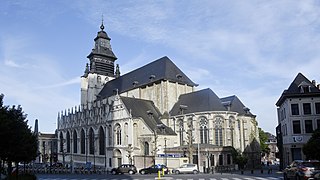
The Church of Our Lady of the Chapel, or the Chapel Church, is a Catholic church in the Marolles/Marollen district of Brussels, Belgium. It is dedicated to Our Lady of the Chapel.

The Church of the Holy Salvation or Holy Saviour was a Pre-Romanesque church in the Dalmatian Hinterland, Croatia, whose ruins are now a historic site. It is located in the small village of Cetina, near the spring of the river Cetina, 8 km northwest from the town of Vrlika.

The Klis Fortress is a medieval fortress situated above the village of Klis, near Split, Croatia. From its origin as a small stronghold built by the ancient Illyrian tribe Dalmatae, to a role as royal castle and seat of many Croatian kings, to its final development as a large fortress during the Ottoman wars in Europe, Klis Fortress has guarded the frontier, being lost and re-conquered several times throughout its 2,000-year history. Due to its location on a pass that separates the mountains Mosor and Kozjak, the fortress served as a major source of defense in Dalmatia, especially against the Ottoman Empire. It has been a crossroad between the Mediterranean Sea and the Balkans.

The Cathedral of Saint Domnius, known locally as the Sveti Dujam or colloquially Sveti Duje, is the Catholic cathedral in Split, Croatia. The cathedral is the seat of the Archdiocese of Split-Makarska, currently headed by Archbishop Zdenko Križić. The Cathedral of St. Domnius is a complex of a church, formed from an Imperial Roman mausoleum, with a bell tower; strictly the church is dedicated to the Virgin Mary, and the bell tower to Saint Domnius. Together they form the Cathedral of St. Domnius.

Croatian Pre-Romanesque art and architecture or Old Croatian Art is Pre-Romanesque art and architecture of Croats from their arrival at Balkans till the end of the 11th century when begins the dominance of Romanesque style in art; that was the time of Croatian rulers.

Trpimir I was a duke in Croatia from around 845 until his death in 864. He is considered the founder of the Trpimirović dynasty that ruled in Croatia, with interruptions, from around 845 until 1091. Although he was formally vassal of the Frankish Emperor Lothair I, Trpimir used Frankish-Byzantine conflicts to rule on his own.

The Flag of Split is the vexillological symbol of the city of Split in Croatia. The flag is navy blue with stylized repeated name of the city symbolizing the bell tower of the Cathedral of St. Dominus raising above the historic city center.
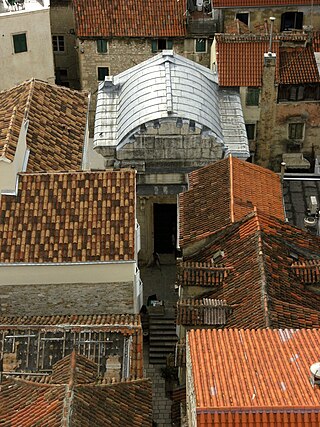
The Temple of Jupiter(Croatian: Jupiterov hram) is a temple in Split, Croatia dedicated to the Ancient Roman god Jupiter. It is located in the western part of Diocletian's Palace near the Peristyle, the central square of the imperial complex. It was built between 295 and 305, during the construction of the Palace, and was probably turned into a Baptistery of St. John the Baptist in the 6th century, at the same time when the crypt dedicated to St. Thomas was built. Before the entrance to the Temple is one of the twelve sphinxes brought from Egypt by Emperor Diocletian. Scottish architect Robert Adam considered this temple to be one of Europe's most beautiful monuments.
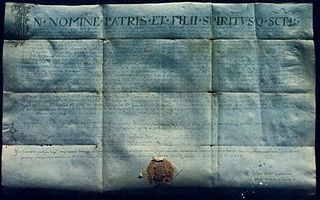
Charter of Duke Trpimir, also known as Trpimir's deed of donation is the oldest preserved document of the Croatian law, the oldest from the court of one of the Croatian rulers and the first national document which mentions the Croatian name. Charter, dated to 4 March 852, is not preserved in its original form but in five subsequent transcripts out of which the oldest is from year 1568.
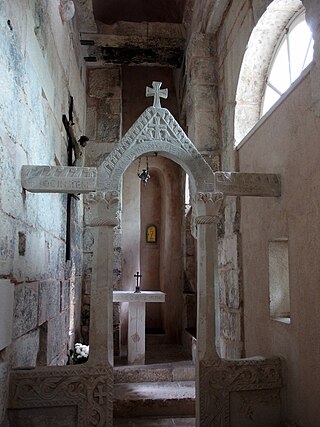
St. Martin's Church is a Roman Catholic church in Split, Croatia. Built into a small space within the ancient Golden Gate of Diocletian's northern wall, it is one of the oldest churches in the city. St. Martin's Church is one of Split's tourist attractions and is known for its fine 11th century chancel screen. It is currently in the care of the Dominican sisters, who have a monastery next door. The church itself is open to public visits.
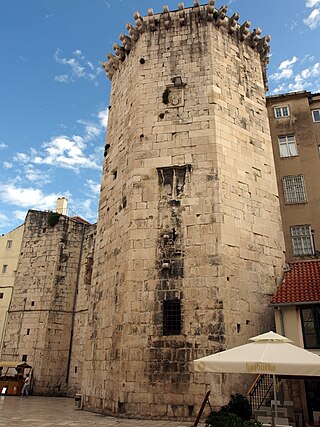
The Venetian Castle was a medieval castle built during the 15th century in Split, present-day Croatia. Built just south-west of the Diocletian's Palace along the shoreline, the castle had an irregular pentagonal shape with three towers facing north and overlooking the city. The decision to build the castle was made in 1424, however, it wasn't until 1441 that it was actually built on the grounds of a demolished monastery. By the early 16th century, the castle was in poor condition and it wasn't until the first half of the 17th century that work on improving it began.

The Golden Gate, or "the Northern Gate", is one of the four principal Roman gates into the stari grad of Split. Built as the main gate of Diocletian's Palace, it was elaborately decorated to mark its status. Over the course of the Middle Ages, the gate was sealed off and lost its columns and statuary. It was reopened and repaired in modern times and now serves as a tourist attraction.
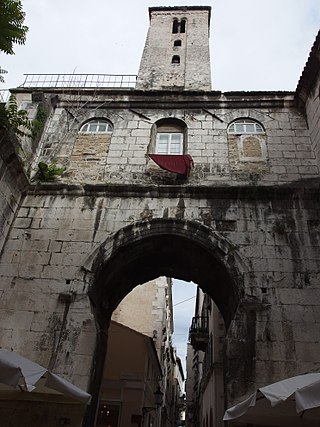
The Iron Gate, or "the Western Gate", is one of the four principal Roman gates into the stari grad of Split that was once Diocletian's Palace. Originally a military gate from which troops entered the complex, the gate is the only one to have remained in continuous use to the present day.

The Silver Gate, or "the Eastern Gate", is one of the four principal Roman gates into the stari grad of Split that was once Diocletian's Palace. The gate faces east towards the Roman town of Epetia, today Stobreč.

The Vestibule, also known as The Rotonda or The Atrium, is the first section of the imperial corridor in Diocletian's Palace that led from the Peristyle, which was once the formal entrance to the imperial apartments.

The Cellars of Diocletian's Palace, sometimes referred to as the "basement halls", is a set of substructures, located at the southern end of Diocletian's Palace, that once held up the private apartments of Emperor Diocletian and represent one of the best preserved ancient complexes of their kind in the world.

Rupotine is an archeological site near Solin, Croatia, which is believed by Croatian archaeologists to be the site of medieval Rižinice monastery. It is considered one of the most significant early medieval Croatian archeological sites due to the inscription of duke Trpimir "PRO DUCE TREPIME(ro)" which was found here.
























